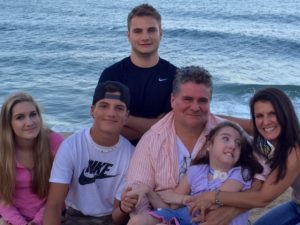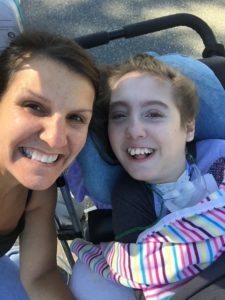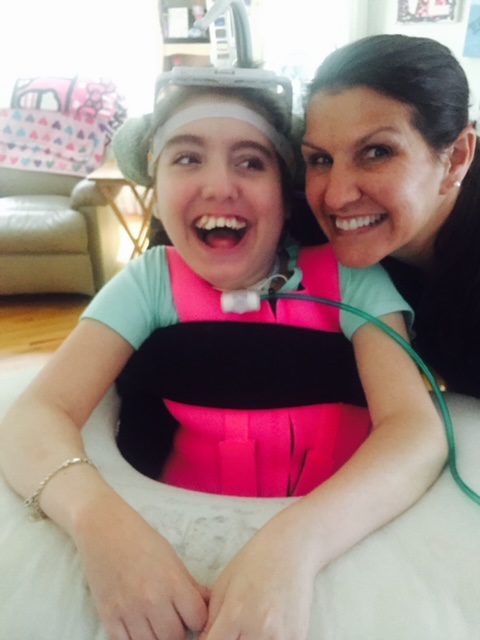Kelly Heger, founder of the AADC Family Network, shares her story of becoming a nurse to take care of her daughter with AADC deficiency.
When my daughter, Jillian, was born in 1995, I had no idea of the journey that we would take together, but we soon realized that it would be unique. Not long after her birth, Jillian was having trouble reaching a stable body temperature. Jillian spent a month in the hospital, where she was tested for just about anything the physicians could think of. But in the end, the hospital couldn’t identify the source of her symptoms. As a new mom, I was scared but hoped for the best.
At three months of age, my daughter was too weak to hold her head up on her own, and she began to experience seizure-like episodes along with excessive sweating and low blood pressure. She also experienced oculogyric crises, which are categorized by abnormal rotation of the eyeballs, muscle spasms, and uncontrolled head and neck muscle action. We saw many more doctors, and we finally got an answer. At this point, Jillian became the fourth child in the world—and the youngest, thus far—to be diagnosed with aromatic l-amino acid decarboxylase (AADC) deficiency, an ultra-rare, life-threatening, fatal genetic disorder.
Learning to Live with the Disease
When our family was just learning about Jillian’s diagnoses, my main concern was figuring out a way to ensure my daughter had access to the 24-hour care that she desperately needed. I was 28 at the time and had no idea where to start. There is no manual for parenthood, and this was a guide that I desperately needed. I was overwhelmed, and ultimately consumed, by the need for answers that just didn’t exist because the resources at the time were so limited. All of my time was spent visiting health care professionals and inpatient hospital teams to come up with a plan for Jillian, all while doing my best to also raise my three other children.
This journey made me realize that I needed to take my daughter’s care into my own hands as well as support others who were yet to find themselves in the same position we were in. I decided to enroll in nursing school so I could provide the best support for my child and strengthen her foundation of support.
About Aromatic L-amino Acid Decarboxylase (AADC) Deficiency
Through my journey, I learned that AADC deficiency is an ultra-rare genetic inborn error of metabolism which affects the biosynthesis and transport of dopamine and serotonin, two critical neurotransmitters in the brain. Neurotransmitters are the naturally occurring chemical substances in the brain which are used to transfer messages between different brain cells. This enzyme deficiency interferes with the communication between cells in the nervous system and is crucial for overall development and motor function of the body. AADC deficiency is often left undiscovered and untreated due to a lack of awareness about the disease. It comes with many symptoms, including hypotonia, developmental delay, tremors and dystonia, and vomiting – to name only a few.
Building a Foundation for Everyone
There is no cure for AADC deficiency. It’s every parent’s worst fear. Learning that there are currently no approved therapies that address the underlying cause of this horrible disease, and that patients with severe forms have a high risk of death during childhood was—and still is—crushing. It’s for this reason that I’ve dedicated my life to advocating for patients like Jillian by founding the AADC Family Network, which promotes awareness, provides advocacy, and assists other AADC deficiency families working to navigate the disease. Through AADC Family Network, I’ve been able to build the system of support that wasn’t available for my family when Jillian was diagnosed.
Our mission is to help families in all areas related to AADC, including funding to assist families experiencing financial challenges. We work to provide support and resources that enable children diagnosed with AADC to live at home as well as have access to any and all treatment available for the disease, including new treatment approaches like gene therapy. It is my goal to provide comfort to other mothers and caregivers by letting them know that they are not alone, and we are in this together.
Today, Jillian is 26 years old and still receiving full-time support. She is an angel and has the most amazing spirit. We have built our own in-home hospital to allow her to be comfortable at home. Jillian loves to be included in everything, and it’s important to always ensure that Jillian and others with AADC deficiency don’t miss out on life’s precious moments due to the burden of their disease. Despite her pain, Jillian is clever, witty, and brave. My dream is for Jillian to walk and talk one day, and ultimately live life without the barriers that she’s had to endure for so long. Only together can we achieve this for all patients.


Kelly Heger Bio
Kelly Heger, 54, is a mother of four children and the primary caregiver of her daughter Jillian, 26, who was the fourth child in the world to be diagnosed with the ultra-rare condition aromatic l-amino acid decarboxylase (AADC) deficiency. Following Jillian’s diagnosis, Kelly decided to attend nursing school to earn her RN and provide 24/7 care for her daughter. AADC deficiency is often left undiscovered and untreated due to a lack of awareness about the disease – something that Kelly strives to change. There is currently no cure for the disease, and no approved therapies that address the underlying cause of AADC deficiency. There is a significant unmet need for effective treatment to help patients like Jillian and provide hope for caregivers. Today, Kelly dedicates her time and resources towards building awareness around Jillian’s story and AADC deficiency. Kelly is the Founder of the AADC Family Network, which promotes awareness, provides advocacy, and assists other AADC deficiency families working to navigate the disease. The foundation also aims to support other children who live at home with their families. Kelly resides in Bridgewater, Massachusetts with her family, where she devotes herself to building awareness towards AADC deficiency and bring impacted families closer together in a strong support system she has built throughout the years.


